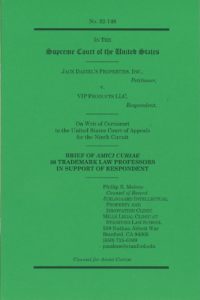Juelsgaard Clinic Asks Supreme Court to Protect Free Speech from Trademark Lawsuits
Can a famous brand use trademark lawsuits to chill lawful speech protected by the First Amendment?
Juelsgaard Intellectual Property and Innovation Clinic students Victoria Fang (JD ’24) and Julia Laurence (JD ’24) recently filed an amicus brief urging the Supreme Court to answer “no” to that question and protect free expression. The Clinic submitted the brief on behalf of a group of trademark law professors in the Jack Daniel’s Properties, Inc. v. VIP Products LLC trademark lawsuit between the well-known whiskey distillery and a dog toy manufacturer.
Thirty of the country’s most prominent trademark law professors joined the Clinic’s brief, led by Stanford Law School’s Mark A. Lemley and UCLA School of Law’s Mark P. McKenna. The Clinic worked with the professors to advocate for the orderly development of trademark law in a way that serves the public interest.
At the center of the lawsuit is a parody dog toy called “Bad Spaniels,” which was introduced by VIP Products as part of its “Silly Squeakers” line almost a decade ago.

The Clinic’s brief explained to the Court that the “Bad Spaniels dog toy is unambiguously a joke (though one that Jack Daniel’s does not appreciate), and that joke is at the heart of what consumers are buying when they buy a VIP toy . . . Trademark law does not give Jack Daniel’s the right to prevent others from making a joke at their expense, even if the vehicle for the joke is a dog toy.”
It is this tension between the interests of trademark law—protecting brands and consumers from confusion in making purchasing decisions—and the public interest in free speech under the First Amendment that the “Bad Spaniels” case highlights. As another court described the speech-trademark conflict in another case, “[i]f this were a sci-fi melodrama, it might be called Speech-Zilla meets Trademark Kong.” *
Jack Daniel’s asserts that the humorous dog toy, which states on its tag that it is “not affiliated with Jack Daniel Distillery,” is an infringing use of its trademarks that should not be allowed. The amicus brief counters that the toy, which parodies the famous whiskey distillery’s marks, should be subject to First Amendment protection, not a trademark infringement lawsuit.
The Supreme Court will determine in this case which legal test courts should use to evaluate consumer confusion in trademark infringement lawsuits involving speech. One is the “multifactor likelihood-of-confusion test” developed in the 1960s. Another is called the “Rogers test” based on the case Rogers v. Grimaldi, 875 F.2d 994 (2d Cir. 1989). The Clinic’s amicus brief argued that a test similar to the Rogers test is best for safeguarding speech in expressive works.
Expressive works include parody, satire, and artistic or political speech. As explained in the Clinic’s brief, lower courts have recognized for decades that expressive works are not only traditional forms of media such as movies, books, and plays, but also other goods sold in the commercial marketplace such as video games, music, calendars, and greeting cards.
The Clinic’s brief argued that the history of trademark law necessitates a Rogers-like test for expressive works. Highlighting the scholarship and expertise of its amici—all law professors with deep experience researching and teaching trademarks—the brief explained that when the multifactor likelihood-of-confusion test was first developed by courts, no one imagined that trademark infringement lawsuits would apply to expressive works.
As a result, the multifactor test was not designed for cases involving expressive works. Rather, the multifactor test’s likelihood-of-confusion factors were originally developed by courts for cases involving goods that were closely related to each other. In recent decades, however, trademark law has dramatically expanded. Courts have tried to apply the multifactor test to expressive works, but the results have been inconsistent and unprincipled.
It is no surprise that courts have inconsistently applied the likelihood-of-confusion factors because those factors are fundamentally ill-suited for evaluating expressive works. This uncertainty in how courts apply the factors leads to prolonged and expensive litigation, often making litigation so burdensome that it scares off lawful users or makes it impossible for them to win. Without an early threshold test for free expression, which the Rogers test provides, the multifactor test will continue to chill legitimate speech. This is why the Clinic’s brief urged the Court to adopt a Rogers-like test.
The Clinic’s brief also pointed out serious flaws in the government’s amicus brief filed by the Solicitor General in support of Jack Daniel’s. The Clinic’s brief showed that the government mischaracterized both the Rogers decision and the current federal trademark statute known as the Lanham Act, emphasizing how the government ignored “decades of case law” on trademark infringement claims.
The Clinic called out the government’s mischaracterizations that the Rogers test is somehow limited to the titles of works simply because the Rogers case involved actress Ginger Rogers suing over her first name being used in the title of a movie. Since the Rogers decision over three decades ago, courts across the board have “uniformly understood” that Rogers protection extends well beyond the title of an expressive work, where expressive works have included everything from t-shirts to the content within video games.

The Clinic’s amicus brief was filed alongside seven others in support of VIP Products. Quoted in a recent Law360 article, counsel for VIP Products commented, “While some may have thought VIP Products the underdog, it turns out that Bad Spaniels runs with a mighty pack poised to defend the right to howl. We are honored and gratified to be supported by such distinguished professors of trademark and First Amendment law, advocates of free speech, and fellow practitioners of creative arts.”
The Supreme Court will hear oral argument in the case of Jack Daniel’s Properties, Inc. v. VIP Products LLC on March 22, 2023. A decision is expected by the end of the term in late June or early July 2023.
For additional news coverage of the Clinic’s amicus brief, see Bloomberg Law’s article “Justices Asked to Literally Connect the Dots in Dog Toy IP Case” and Tech Dirt’s “MSCHF One Ups The Onion In Filing Hilarious Supreme Court Amicus Briefs That Educate.”
____________________
* Mattel, Inc. v. MCA Records, Inc., 296 F.3d 894, 898 (9th Cir. 2002).

